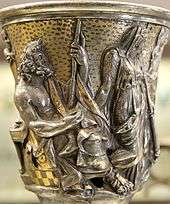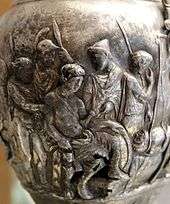Berthouville Treasure

The Berthouville treasure is a hoard of Roman silver uncovered by ploughing in March 1830[1] at the hamlet of Villeret[2] in the commune of Berthouville in the Eure département of Normandy, northern France. Purchased at the time of discovery for a modest 15,000 francs, the treasure is conserved in the Cabinet des Médailles at the Bibliothèque nationale, Paris.[3]
Discovery
The Berthouville hoard was discovered when a ploughshare struck a Roman tile. Once dislodged, the tile uncovered the hastily buried temple treasure[4] a mere 20 cm beneath the modern surface.
The treasure belonged to a sanctuary of Mercury Canetonensis. In the mid 1st century BCE, Julius Caesar had identified Mercury as one of the main deities of Gaul.[5] In his Gallo-Roman form Mercury is frequently found with a Gaulish epithet.
The treasure
The treasure consists of silver and other metalwork, of varying type, quality and dates in the 1st to late 2nd centuries of the Common Era. The trésor de Berthouville is one of only three known depositories securely associated with local religious cult in Gaul and Britannia.[6] The hoard was hidden in the late 2nd or early 3rd century, but contained heirloom pieces like the repoussé silver jug that was made in Italy in the 1st century CE. The find totaled 93 items, some of which were dissociated handles and silver appliqués, with a total weight of 25 kg. Most of the items are bowls, cups and jugs,[7] but there is also a phiale for libations.[8]
There are also two silver statuettes of Mercury (the larger 60 cm tall) and a silver bust of a goddess, probably his mother Maia,[9] perhaps representing Romanized versions of Gallic deities. The pairing of a Roman god with a Gallic goddess would be characteristic of Gallo-Roman religion.[10]
Four of the bowls have incised emblematic designs associated with Mercury, and the formulaic Latin initialism VSLM, standing for votum solvit libens merito ("He fulfills his vow freely, as is deserved").[11] Nine of the vessels form a group of luxury domestic silver of 1st century date[12] with iconographic connections to Dionysus rather than to Mercury, marked as votive offerings (vota) of one Q. Domitius Tutus; they include a matching pair of silver drinking cups (scyphi) with Dionysiac imagery of centaurs,[13] and a pair of silver wine-jugs.[14]
Excavations near the find-spot in 1861-62 and 1986[15] revealed a Gallo-Roman theatre and a shrine that may have been the shrine to which the silver objects had been dedicated.
Conservation
The Berthouville treasure is currently at the Getty Villa in Malibu, California, where it is being studied and conserved as part of collaborative multi-year project between the J. Paul Getty Museum and the Cabinet des Médailles. The restored treasure will be exhibited at the Getty Villa in 2014.[16]
Notes
- ↑ The 21 March, by Prosper Taurin, according to Auguste Le Prévost, who had been born nearby at Bernay (Prévost, Mémoire sur la collection de vases antiques trouvée en 1830 à Berthouville (arr. de Bernay), Caen, 1832:6); Archives relative to the acquisition of the Berthouville Treasure, B.N. 8 AMC 35 (1830) Archived May 3, 2008, at the Wayback Machine..
- ↑ Date and location as noted in Mémoires de la Société nationale des antiquaires de France 6th series, vol. 8 (1897:228-32), reporting M. Join-Lambert's excavations of two temples, a theatre and wells near the site in 1896.
- ↑ Ernest Babelon (director of the département des monnaies, médailles et antiques, BN), Le trésor d'argenterie de Bertouville près de Bernay (Eure) conservé au Département de médailles et antiques de la Bibliothèque nationale, Paris 1916; Ruth E. Leader-Newby, Silver and Society in Late Antiquity: Functions and Meanings of Silver Plate (Ashgate) 2004; D.E. Strong, Greek and Roman Gold and Silver Plate (London 1968)
- ↑ On Roman temple treasures in general, see A. Henwood Griffiths, Temple Treasures: A Study Based on the Works of Cicero and the Fasti of Ovid (Philadelphia 1943).
- ↑ Caesar, Commentaries on the Gallic War vi. §17.
- ↑ Leader-Newby 2004:72. The other two are the Notre-Dame d'Allençon Treasure and the Thetford Hoard.
- ↑ Karl Lehmann-Hartleben, "Two Roman Silver Jugs" American Journal of Archaeology 42.1 (January–March 1938:82-105).
- ↑ Charles Waldstein, "A Hermes in Ephesian Silver Work on a Patera from Bernay in France", The Journal of Hellenic Studies 3 (1882:96-106).
- ↑ Ruth E. Leader-Newby, Silver and Society in Late Antiquity: Functions and Meanings of Silver Plate Ashgate; 2004; p. 73
- ↑ Rosmerta, for instance, was frequently associated with Mercury in Gaul.
- ↑ Ruth E. Leader-Newby, Silver and Society in Late Antiquity: Functions and Meanings of Silver Plate Ashgate. 2004.
- ↑ Similar to silver found at Boscoreale and in the House of the Menander at Pompeii, overwhelmed by the eruption of 79 CE, and similarly composed of drinking vessels (Leader-Newby).
- ↑ Jon van de Grift, "Tears and Revel: The Allegory of the Berthouville Centaur Scyphi" American Journal of Archaeology 88.3 (July 1984:377-388).
- ↑ K. Lehmann, "Two Roman silver jugs", American Journal of Archaeology 42 (1938:82-105).
- ↑ Noted in Leader-Newby 2004:114 note 64.A bust of Hermaphroditus was discovered at Bernay in 1864 occasioned some correspondence with M. Cornu of Bernay in 1864-65 (Archives, B.N., 12 AMC 12, 12 AMC 14 Archived May 3, 2008, at the Wayback Machine.).
- ↑ Eduardo P. Sanchez and Susan Lansing Maish, "Welcoming the Berthouville Treasure to the Getty Villa", The Iris: Views from the Getty, October 18, 2011
Further reading
| Wikimedia Commons has media related to Berthouville treasure. |
- Ch. Picard, Un cénacle littéraire hellénistique sur deux vases d' argent du trésor de Berthouville-Bernay MonPiot 44, (1950:5ff).
- Lapatin, Kenneth, ed. (2014-11-18). The Berthouville Silver Treasure and Roman Luxury. Getty Publications. ISBN 9781606064207.
Coordinates: 49°10′24″N 0°37′17″E / 49.17333°N 0.62139°E
